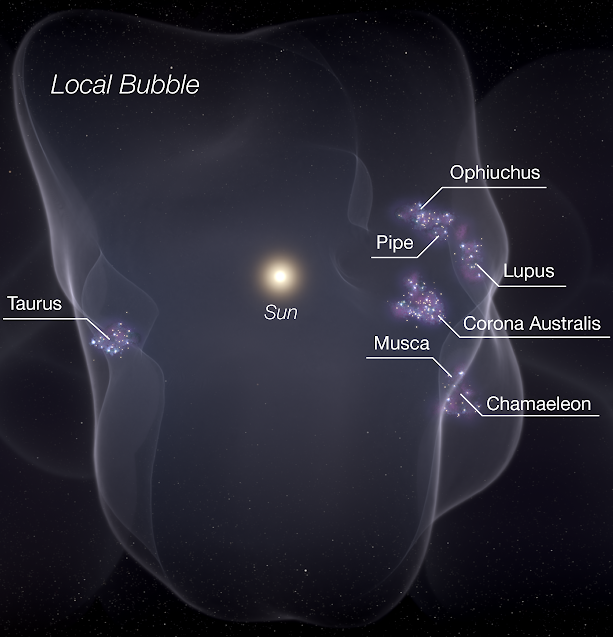|
G-cloud
The G-Cloud (or G-Cloud complex) is an interstellar cloud located next to the Local Interstellar Cloud, within the Local Bubble. It is unknown whether the Solar System is embedded in the Local Interstellar Cloud or in the region where the two clouds are interacting, although the Solar System is currently moving towards the G-Cloud. The G-Cloud contains the stars Alpha Centauri (a triple star system that includes Proxima Centauri) and Altair (and possibly others). Estimates for the n(H I region, H I) particle density in the direction of Alpha Centauri. were made in 2011 by Crawford as 0.1 cm−3 and in 2014 by Gry as 0.098 cm−3. References G-Cloud, {{astrophysics-stub ... [...More Info...] [...Related Items...] OR: [Wikipedia] [Google] [Baidu] |
Local Interstellar Cloud
The Local Interstellar Cloud (LIC), also known as the Local Fluff, is an interstellar cloud roughly across, through which the Solar System is moving. This feature overlaps a region around the Sun referred to as the solar neighborhood. It is unknown whether the Sun is embedded in the Local Interstellar Cloud, or is in the region where the Local Interstellar Cloud is interacting with the neighboring G-Cloud. Like the G-Cloud and others, the LIC is part of the Very Local Interstellar Medium which begins where the heliosphere and interplanetary medium end, the furthest that probes have traveled. Structure The Solar System is located within a structure called the Local Bubble, a low-density region of the galactic interstellar medium. Within this region is the Local Interstellar Cloud (LIC), an area of slightly higher hydrogen density. It is estimated that the Solar System entered the LIC within the past 10,000 years. It is uncertain whether the Sun is still inside of the LIC or h ... [...More Info...] [...Related Items...] OR: [Wikipedia] [Google] [Baidu] |
Interstellar Cloud
An interstellar cloud is generally an accumulation of gas, plasma, and dust in our and other galaxies. Put differently, an interstellar cloud is a denser-than-average region of the interstellar medium, the matter and radiation that exists in the space between the star systems in a galaxy. Depending on the density, size, and temperature of a given cloud, its hydrogen can be neutral, making an H I region; ionized, or plasma making it an H II region; or molecular, which are referred to simply as molecular clouds, or sometime dense clouds. Neutral and ionized clouds are sometimes also called ''diffuse clouds''. An interstellar cloud is formed by the gas and dust particles from a red giant in its later life. Chemical compositions The chemical composition of interstellar clouds is determined by studying electromagnetic radiation that they emanate, and we receive – from radio waves through visible light, to gamma rays on the electromagnetic spectrum – that we receive from them. ... [...More Info...] [...Related Items...] OR: [Wikipedia] [Google] [Baidu] |
Local Bubble
The Local Bubble, or Local Cavity, is a relative cavity in the interstellar medium (ISM) of the Orion Arm in the Milky Way. It contains the closest of celestial neighbours and among others, the Local Interstellar Cloud (which contains the Solar System), the neighbouring G-Cloud, the Ursa Major Moving Group ( the closest stellar moving group) and the Hyades (the nearest open cluster). It is at least 300 light years across, and is defined by its neutral-hydrogen density of about 0.05 atoms/cm3, or approximately one tenth of the average for the ISM in the Milky Way (0.5 atoms/cm3), and one sixth that of the Local Interstellar Cloud (0.3 atoms/cm3). The exceptionally sparse gas of the Local Bubble is the result of supernovae that exploded within the past ten to twenty million years. Geminga, a pulsar in the constellation Gemini, was once thought to be the remnant of a single supernova that created the Local Bubble, but now multiple supernovae in subgroup B1 ... [...More Info...] [...Related Items...] OR: [Wikipedia] [Google] [Baidu] |
Solar System
The Solar SystemCapitalization of the name varies. The International Astronomical Union, the authoritative body regarding astronomical nomenclature, specifies capitalizing the names of all individual astronomical objects but uses mixed "Solar System" and "solar system" structures in theinaming guidelines document. The name is commonly rendered in lower case ('solar system'), as, for example, in the ''Oxford English Dictionary'' an''Merriam-Webster's 11th Collegiate Dictionary''. is the gravity, gravitationally bound system of the Sun and the objects that orbit it. It Formation and evolution of the Solar System, formed 4.6 billion years ago from the gravitational collapse of a giant interstellar molecular cloud. The solar mass, vast majority (99.86%) of the system's mass is in the Sun, with most of the Jupiter mass, remaining mass contained in the planet Jupiter. The four inner Solar System, inner system planets—Mercury (planet), Mercury, Venus, Earth and Mars—are terrest ... [...More Info...] [...Related Items...] OR: [Wikipedia] [Google] [Baidu] |


